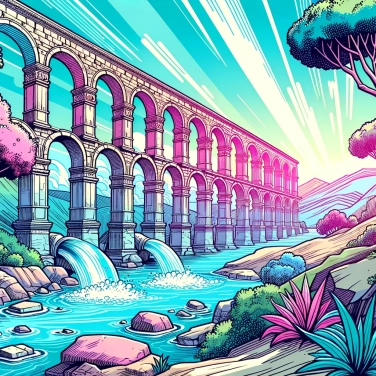The Romans used aqueducts to transport water because it allowed them to bring water from distant sources to the cities where it was needed, thus facilitating the supply of drinking water and the irrigation of agricultural lands.

For the Romans, access to water was often synonymous with power and comfort. They understood early on that clean water was not only useful for drinking, cooking, or washing, but essential for keeping citizens healthy and preventing a host of diseases. Public baths, for example, were almost sacred and indispensable to daily life. Water was also a key element for agriculture, allowing for significant harvests to feed a large and growing population. In short, no water, no prosperous Rome. It’s no wonder they invested so much effort in building ingenious systems to bring it into their cities.
In Rome, water was abundant in certain areas, but rarely in direct proximity to the cities. Between distant rivers, mountain springs, and steep terrain, transporting water to urban centers was a real challenge. The Romans faced deep valleys, mountains that were not easy to bypass, and fields that complicated construction. Technically, without modern pumps and elaborate pressure systems, water had to flow down gentle slopes to run freely. This limited route options, and Roman engineers had to be extremely precise to maintain a consistent gradient over long distances. Another issue was the materials: it was necessary to choose solid, waterproof stones that were easy to handle to avoid leaks and collapses. In short, the terrain and technical constraints made this gigantic engineering feat difficult but essential.
The Romans built aqueducts primarily to transport water over long distances to cities, mainly utilizing gravity. This system was a brilliant invention: water flowed gently downhill from distant springs to large cities, eliminating the need for pumping. The aqueducts provided a regular and reliable flow, continuously supplying public fountains, baths, private baths, and even agricultural spaces. This allowed cities to have access to a sufficient amount of clean (or nearly clean) water for the daily use of their inhabitants, as well as for the disposal of wastewater, which improved public hygiene. In short, with aqueducts, the Romans had found a simple yet ingenious way to solve their water problems without unnecessarily complicating things.
The Romans were very clever: by building aqueducts, they could bring water wherever they wanted, even to remote or very dry regions. This allowed their cities and colonies to grow rapidly due to a constant supply of water for housing, agriculture, and even the public baths that were so popular in Roman society. Thanks to the aqueducts, Rome could conquer new territories while being sure it could provide drinking water to all its citizens and soldiers (it helps avoid some revolts). Having such infrastructure also gave them a significant strategic advantage over enemy peoples, as it ensured better health and greater economic strength throughout the Empire. In short, the aqueducts were a true pillar of Roman power, facilitating territorial expansion while maintaining the stability of their civilization for centuries.
Roman aqueducts are a bit like the ancestors of our current running water networks. Their technique relied mainly on gravity and a constant slope to transport water over miles. Even today, the principle remains the same for our drinking water supply: create an adequate slope and use natural gravity rather than pumping constantly. The same applies to modern sanitation and agricultural irrigation technologies, which take inspiration from the Roman idea of efficient and reliable piping systems. Even in our urban sewers, the inspiration is evident, with structured, well-thought-out, and sustainable networks that clearly resemble those ingenious Romans. In short, the Roman concept of transporting water has endured through the centuries because it was simply clever, efficient, and perfectly logical.
The famous aqueduct of the Pont du Gard, built in the 1st century AD, still transports water today thanks to its exceptional engineering and structural integrity!
The Romans used natural filtration techniques such as settling basins to remove impurities before distributing water to fountains and homes.
To precisely control the flow of water, Roman engineers sometimes used pipes made of lead called fistulae, which facilitated accurate distribution throughout the city.
Every Roman citizen had access on average to more drinking water than a contemporary citizen of a large European city at the beginning of the 20th century, a remarkable testament to Roman efficiency in water management!
Yes, many Roman aqueducts still exist throughout Europe and are important tourist attractions today. Among the most famous are the Pont du Gard in France and the Aqueduct of Segovia in Spain, both of which are well-preserved and open to visitors.
The Romans also used local wells and waterways, but in large cities, the growing population and increased demand for drinking water and bathing necessitated amounts of water that they could not meet simply from these local sources. Aqueducts allowed them to bring in more abundant water from distant sources.
Yes, the water carried by the aqueducts was generally potable. The Romans carefully selected high-quality natural sources that were fresh and clear. Furthermore, the water flowing through the aqueducts was regularly subjected to natural settling processes, thereby improving its quality before it was distributed to the cities.
Roman aqueducts could transport enormous volumes of water. For example, the Aqua Claudia aqueduct supplied Rome with about 190,000 cubic meters of water each day, feeding several neighborhoods, public baths, fountains, and private villas.
The Romans primarily used ingenious surveying and topographical measurement methods to determine optimal slopes. They combined natural gravity with arches, tunnels, and bridges to transport water over long distances without complex modern equipment.

No one has answered this quiz yet, be the first!' :-)
Question 1/5